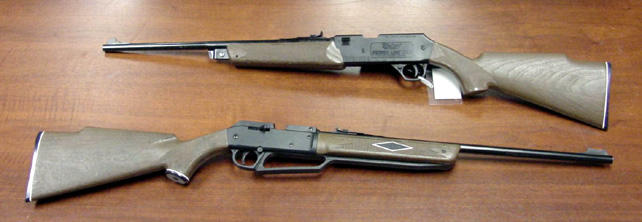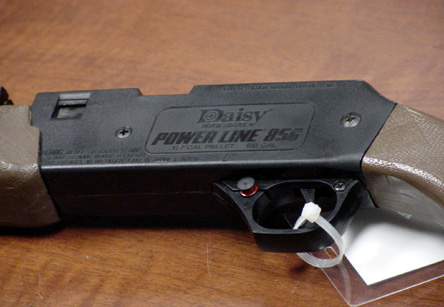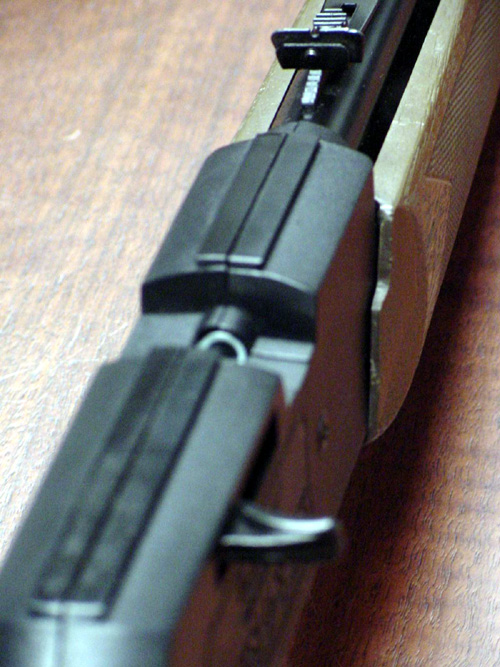The U.S. Consumer Product Safety Commission (CPSC) today filed an administrative lawsuit (pdf) against the Daisy Manufacturing Co. (Daisy), doing business as Daisy Outdoor Products, of Rogers, Ark., seeking a recall of 7.5 million Powerline Airguns. The lawsuit seeks to compel Daisy to notify consumers that the model 880 and model 856 Powerline Airguns are defective, and present a substantial risk of death or injury to anyone using the airgun. Daisy has refused to voluntarily recall these BB guns, which have been sold since September 1972 in sporting goods, department, and hardware stores, as well as on the Internet.
CPSC's staff has learned of at least 15 deaths and 171 serious injuries that have been attributed to alleged design and manufacturing defects in Daisy's Powerline Airguns. About eighty percent of those who have been killed or injured by the airguns were children under the age of 16. Children have been killed after being shot in the head or chest. Other children have been seriously injured after BBs punctured the heart, spinal cord, or skull, causing paralysis and brain damage.
CPSC began an investigation in May 2000 following reports that Daisy had made changes to the model 856 Powerline Airgun in order to correct potential design defects. The lawsuit filed by CPSC staff alleges that Daisy's Powerline Airguns are still defective because BBs can become lodged in the magazine of the airguns, even though the airgun can appear empty. It is foreseeable that a child, believing the BB gun is empty, could play with Daisy's Powerline Airgun in an unsafe manner. The stuck BB can then become dislodged, causing death or serious injury if fired in the direction of another person. CPSC staff believes that all 856 and 880 model airguns sold by Daisy have this defect.
The CPSC lawsuit also contends that Daisy's Powerline Airguns' failure to incorporate an automatic safety system makes the BB guns defective. Daisy's Powerline Airguns currently have a manual safety button on them.
One of the many tragic incidents that CPSC learned about involved John "Tucker" Mahoney, of New Hope, Pa. On May 24, 1999, Tucker and his friend were shooting a model 856 Powerline, two days after he had received the airgun as a gift for his 16th birthday. CPSC staff contends that as a result of a defect within the airgun, a BB remained lodged inside of the airgun's magazine, unbeknownst to Tucker or his friend. Believing the airgun was unloaded, Tucker's friend pointed and fired the airgun at close range. The hidden BB became dislodged, chambered, and struck Tucker in the head. Tucker was severely injured and is now in a near vegetative state. In February 2001, Daisy settled Tucker's product liability lawsuit for approximately $18 million dollars.
CPSC staff believes that it would cost $2 per airgun to correct the defect that causes BBs to become lodged in the loading mechanism and to put an automatic safety device on the airgun.
CPSC staff filed the lawsuit against Daisy under Section 15 of the Consumer Product Safety Act and Section 15 of the Federal Hazardous Substances Act. The administrative complaint does not seek a ban on all airguns or all Daisy airguns. The complaint seeks a recall of these two models of airguns which staff believes are defective.
CPSC's case will be heard by an administrative law judge.

Daisy 856 Model (top) and 880 Model (bottom) Powerline Airguns

Close-up of Daisy's 856 Model

Firing Chamber on Daisy's 856 Model
SUMMARY OF THE STATEMENT OF COMMISSIONER GALL IN OPPOSITION TO ISSUANCE OF ADMINISTRATIVE COMPLAINT AGAINST DAISY MANUFACTURING COMPANY
OCTOBER 30, 2001
I voted against the Complaint because:
I. PROCEDURAL IRREGULARITIES
A. The confidential draft Complaint was furnished to reporters yesterday, before vote took place today.
B. Complaint filed immediately after vote today instead of giving Daisy the customary short time to settle prior to filing the Complaint. Timetable driven by today's 2:00 PM press conference.
C. No expert reports or detailed financial information about the company were provided to Commission.
II. MANY ALLEGED DEFECTS ARE GENERIC TO AIR GUNS
A. Gravity feed mechanisms
B. Automatically resetting safeties.
C. Warnings provided to purchasers in labels and operating manuals.
These issues should be addressed through voluntary standards, or regulation, not compliance action directed at one company.
III. LODGING PROBLEM MAY BE UNIQUE TO DAISY BUT IS NOT A SUBSTANTIAL PRODUCT HAZARD.
A. Commission's compliance staff conducted six separate investigations of Daisy BB guns between l981 and l999. Commission considered petitions five times between l975 and l989 and a special staff project and report on air gun safety was completed in l997.
B. Experience in use reveals 3 deaths and 47 serious injuries over 30 years and nearly 7.5 million examples. (Contrast 250 deaths per year associated with the use of bicycles by children.)
C. Commission staff unable to replicate phenomenon despite repeated attempts to do so. Commission has repeatedly looked at airguns in general and Daisy BB guns in particular and has not found a defect.
(Vote was on the basis of the record developed by the staff and presented to the Commission as of October 30, 2001. A record will now be developed by an Administrative Law Judge, and future decisions will be based on that record.)
COMPLETE STATEMENT:
STATEMENT OF THE HONORABLE MARY SHEILA GALL IN OPPOSITION TO ISSUANCE OF ADMINISTRATIVE COMPLAINT AGAINST DAISY MANUFACTURING COMPANY
October 30, 2001
Today I voted against the issuance of an administrative complaint against Daisy Manufacturing Company (Daisy) seeking to force the recall of certain model air rifles. This complaint is highly politicized, it is not well founded in law or the evidence and it should not have been brought.
Procedural Irregularities
The timing of the filing of this Complaint is one in a chain of procedural irregularities that have characterized the handling of the entire Daisy matter. Yesterday some Commission staff furnished the confidential draft Complaint to a reporter and other news organizations before the Commission voted on the issue. News organizations were also informed that the Commission would be holding a press conference at 2:00 p.m. today to announce a matter concerning a consumer product that would involve the mother of a victim. Today the Commission voted to authorize the issuance of the complaint. Normally Commission staff contacts the company involved and gives it one last chance to settle the matter. In this case, however, the Complaint, once authorized, was rushed to the Office of the Secretary to be filed so that the 2:00 p.m. press conference deadline could be met.
Other irregularities have characterized the handling of this case. Although the Commission staff retained both a gunsmith expert and a materials science expert to examine Daisy BB guns alleged to lodge BBs in the magazine or elsewhere, the Commission has no written report from either of these experts. Nor was the work of these experts reviewed by the Commission's own laboratory staff. When I inquired about the reason why no written report was prepared, I was told that it was part of a litigation strategy. From this I conclude that the decision was made early on to litigate this case, and the case was prepared with that objective in mind, rather than the ordinary objective of informing the Commission as thoroughly as possible prior to a vote. In addition to the lack of experts' reports, the staff provided the Commission with only the most rudimentary financial information concerning Daisy's ability to conduct the huge recall contemplated by the Complaint, and the staff never sought a Subpoena and Special Order to compel Daisy to provide financial information. Finally, the briefing memo contains glaring errors of fact, such as a description of a BB being "chambered" into a rifle's "muzzle" and the assertion that Daisy BB guns are more "powerful" than .38 caliber revolvers.
The best explanation for these procedural irregularities can be found in Chairman Ann Brown's August 8, 2001 statement announcing her departure. In that statement she announced both the result of this investigation ("a lawsuit regarding a very dangerous product [which everyone at the Commission knew to be Daisy BB guns] that kills and maims children") and its timetable ("before I leave"). Yet the Commission did not receive its briefing package in the Daisy matter until October 4, 2001. As the Queen of Hearts said in Lewis Carroll's Alice in Wonderland: "Sentence first, verdict afterwards."
Alleged Defects Common to Airgun Designs
The staff's proposed complaint alleges that certain characteristics of the Daisy air rifles in question constitute defects. These characteristics are: (1) the gravity feed magazine design; (2) the color of the feeding ramp; (3) the capability to install a telescopic sight that may impede the ability of the shooter to see a BB in the loading port prior to placing it in the chamber; and (4) the lack of a safety mechanism that resets after each shot. The proposed complaint also claims that Daisy's marketing practices and how users are warned about the hazards associated with the use of the airguns constitute a defect. I find none of these theories of defect persuasive when applied to the specific Daisy designs in question, because they are industry-wide.
The gravity feed magazine is a very common design feature in airguns and has been used for around 100 years. Virtually every manufacturer of airguns either uses or has used a gravity feed magazine design in its airguns. While a gravity feed mechanism may, on occasion, result in a failure to feed a projectile into the loading port, that is also true of controlled feed mechanisms. If the gravity feed mechanism is now to be labeled as defective, the Commission should seek changes that apply to the entire industry through either the voluntary standards setting process, or through the regulatory procedures available to the Commission.
Similar considerations apply to the other alleged defects of Daisy BB guns that are common to all airguns. The Complaint alleges that the color of the Daisy BB gun feed ramp should contrast with the color of Daisy BBs. Feed ramp color and BB color, if they are considered at all, need to be considered through voluntary standards, or through regulation, and certainly not in a recall. The presence of a telescopic sight on a BB gun enhances accuracy for most users. Whether such a sight should be permitted, and how it should be mounted on the airgun's receiver are matters much better suited to an industry-wide solution rather than a recall aimed at specific products. Finally, a safety that resets automatically has been incorporated in a few airgun and firearm designs. Most airgun and firearm designs, however, do not have this feature, and commentors divide in their opinions on whether it enhances or detracts from safety. Again, this issue should be considered in the context of voluntary standards or regulation, not in a recall aimed at one manufacturer and two models of airguns.
Finally, Daisy is accused in the Complaint of marketing the 856 and 880 model airguns to "children," which the Complaint defines as persons under 18. Both the Daisy BB gun packaging and the literature accompanying the rifle, however, contain the warning required by the voluntary standard. Whether these warnings are adequate or whether the age recommendations for high velocity air guns should be changed are industry-wide issues, and should not be litigated in the context of a specific recall.
Lodging of BBs in Daisy BB Guns
The most serious allegation of the Complaint, and one that may be unique to Daisy, is that BBs may lodge in the mechanism of the 856 and 880 airguns without the shooter realizing that they are there. Outside experts hired by the Commission staff, and other experts appear to have determined that this lodging problem exists in the Daisy BB guns and the specific places in which BBs lodge may be unique to the Daisy design. Obviously a BB lodging in the mechanism is a cause for concern. A shooter should be able to unload the rifle with a reasonable degree of assurance that no BBs remain in the mechanism. I note that Daisy has made design changes to the 856 intended to remedy this situation and that the present 856 is a single shot design that dispenses entirely with magazine.
The existence of a problem in a design, however, is not synonymous with either a defect or a substantial product hazard. I note first that the Commission laboratory staff has never been able to replicate the lodging problem, in spite of repeated attempts to do so. In fact, the Commission's Compliance staff conducted six separate investigations of Daisy BB guns between 1981 and 1999. (There was additional Commission activity considering petitions five times between 1975 and 1989, and a special staff project and report on airgun safety in 1997.) At no time was the lodging problem identified as either a defect or a substantial product hazard. This does not mean that the Commission is forever precluded from considering the issue, but it does mean that we should be very careful before making a call of defect or of substantial product hazard.
Experience with Daisy BB guns by their users also leads to the conclusion that the lodging problem does not constitute a substantial product hazard. Daisy has sold nearly five million examples of the Model 880 between 1972 and 2001, and it has sold approximately 2.4 million examples of the Model 856 between 1984 and 2001. The staff has determined that the lodging problem has been associated with three deaths and 47 serious injuries during this period of time. While any death or serious injury is tragic and heart-rending for the family involved, I note that the average number of deaths per year associated with the use of bicycles by children aged under 15 is 250.
Even if a BB is lodged in the magazine or elsewhere in the mechanism of a Daisy BB gun, it cannot be discharged until the shooter performs several deliberate actions:
- Pull the bolt handle to the rear. (At this point the shooter has the opportunity to observe the presence of the BB in the loading port.)
- Push the bolt handle forward.
- Pump up the gun to the desired power level.
- Disengage the safety if it has been engaged.
- Pull the trigger.
Thus, the hazard of a BB lodged in the gun appears only when the shooter deliberately places it in the chamber through the ordinary operation of the mechanism. Moreover, several of the serious accidents involved with these Daisy BB guns have resulted from reckless conduct; where shooters deliberately pointed a gun that had been pumped up at the head or torso of another person and pulled the trigger. Such conduct is a violation of the most basic rules of airgun and firearms safety.
Conclusion
This Compliance action has been the subject of some of the most intense pressure and emotion of any topic during my service as a Commissioner. On the one hand, we have witnessed the devastating results of accidents involving these airguns and the emotional impact that they have on the victims' families. On the other hand, Commissioners' offices have received dozens of calls and hundreds of e-mails from persons who sincerely enjoy the use of airguns, use them safely, and believe that a recall is unjustified. I have considered both of these points of view carefully. My decision is, however, based on the law and the evidence before the Commission. Upon that law and that evidence, I do not believe that it is appropriate for the Commission to authorize the issuance of the Complaint against Daisy. I do believe that the topic of airgun safety merits further study, and a decision in the future by the Commission to possibly use the voluntary standards setting process, the regulatory process, the compliance process, the information and education process, or some mixture of these processes, to achieve the maximum amount of safety consistent with the nature of these products.
My vote today, and this statement, are based on the record.
About the U.S. CPSC
The U.S. Consumer Product Safety Commission (CPSC) is charged with protecting the public from unreasonable risk of injury associated with the use of thousands of types of consumer products. Deaths, injuries, and property damage from consumer product-related incidents cost the nation more than $1 trillion annually. Since the CPSC was established more than 50 years ago, it has worked to ensure the safety of consumer products, which has contributed to a decline in injuries associated with these products.
Federal law prohibits any person from selling products subject to a Commission ordered recall or a voluntary recall undertaken in consultation with the CPSC.
For lifesaving information:
- Visit CPSC.gov.
- Sign up to receive our email alerts.
- Follow us on Facebook, Instagram, X, BlueSky, Threads, LinkedIn and Truth Social.
- Report a dangerous product or a product-related injury on www.SaferProducts.gov.
- Call CPSC’s Hotline at 800-638-2772 (TTY 800-638-8270).
- Contact a media specialist.
Please use the below phone number for all media requests.
Phone: (301) 504-7908
Spanish: (301) 504-7800

